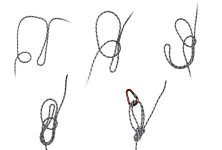Bob Mehew
Well-known member
I have just caught up with this thread. The link provided by Keiran.A requires one to download the whole book (for free). The relevant diagram is on page 35 from the book titled Cave Rescue Techniques 2017 by G Antonini et al, translated by F Cuneo and A Sbisa.
I use the Ashley Book of Knots to provide a reference and with over 20 entries for bowlines, it is going to take some time to check this variant against them. It was obvious from scanning the pages of the book as I looked for the image, that the translation whilst good is not using standard terms such as end / bight / standing part as used in ABOK. So care is needed in reading. The first point is this book shows its bowline on a bight as a mid rope knot where as the usual bowline on the bight is tied at the end of a rope. I have not (yet) read further into the book to see what situations they wish to use this knot for. But the first thought is what are the advantages of this knot over say an Alpine Butterfly knot?
The book states under the title "Information" for this knot that:
Extremely strong and easy to recognize.
It shows a good residual load.
Good for attaching service ropes without using carabiners.
I am struggling to understand these statements. Could some one read more of the book to get into the style of English as well as see if they cite specific examples? I am afraid I am rather busy with other matters (theoretical rope testing and radon) so I am not immediately available to read the book.
I also attach a slightly less fuzy copy of the image which shows its manner of tying and I think clarifies the bit about the stopper if one looks at what has been 'crabed in'.
I use the Ashley Book of Knots to provide a reference and with over 20 entries for bowlines, it is going to take some time to check this variant against them. It was obvious from scanning the pages of the book as I looked for the image, that the translation whilst good is not using standard terms such as end / bight / standing part as used in ABOK. So care is needed in reading. The first point is this book shows its bowline on a bight as a mid rope knot where as the usual bowline on the bight is tied at the end of a rope. I have not (yet) read further into the book to see what situations they wish to use this knot for. But the first thought is what are the advantages of this knot over say an Alpine Butterfly knot?
The book states under the title "Information" for this knot that:
Extremely strong and easy to recognize.
It shows a good residual load.
Good for attaching service ropes without using carabiners.
I am struggling to understand these statements. Could some one read more of the book to get into the style of English as well as see if they cite specific examples? I am afraid I am rather busy with other matters (theoretical rope testing and radon) so I am not immediately available to read the book.
I also attach a slightly less fuzy copy of the image which shows its manner of tying and I think clarifies the bit about the stopper if one looks at what has been 'crabed in'.



